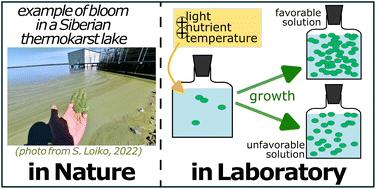当前位置:
X-MOL 学术
›
Environ. Sci.: Processes Impacts
›
论文详情
Our official English website, www.x-mol.net, welcomes your
feedback! (Note: you will need to create a separate account there.)
Laboratory growth capacity of an invasive cyanobacterium (Microcystis aeruginosa) on organic substrates from surface waters of permafrost peatlands
Environmental Science: Processes & Impacts ( IF 4.3 ) Pub Date : 2023-02-03 , DOI: 10.1039/d2em00456a Dahédrey Payandi-Rolland 1 , Liudmila S Shirokova 1, 2 , Julien Larieux 1 , Pascale Bénézeth 1 , Oleg S Pokrovsky 1, 3
Environmental Science: Processes & Impacts ( IF 4.3 ) Pub Date : 2023-02-03 , DOI: 10.1039/d2em00456a Dahédrey Payandi-Rolland 1 , Liudmila S Shirokova 1, 2 , Julien Larieux 1 , Pascale Bénézeth 1 , Oleg S Pokrovsky 1, 3
Affiliation

|
Within a global warming trend, invasive cyanobacteria, abundant in tropical and temperate regions, can migrate northward and colonize thermokarst lakes in permafrost-affected territories. For a better understanding of the cyanobacterial proliferation mechanism in those lakes, we performed laboratory growth of typical invasive cyanobacteria, Microcystis aeruginosa, onto various organic-rich solutions representative of permafrost peatlands. Aqueous leachates of lichen, moss and peat were the most favorable substrates for massive growth. The growth in the presence of all organic substrates produced an increase in solution pH by two units and a sizable (30–50%) decrease in the concentration of dissolved organic carbon. The observed increase in the dissolved organic carbon aromaticity degree likely reflected preferential cyanobacterial uptake of aliphatic, optically transparent organic substances. Cyanobacterial growth over a bloom period can create a carbon sink (uptake of 2.5 and 8.3 g C–CO2 m−2 d−1) that can offset the net heterotrophic status of thermokarst lakes in permafrost peatlands, thus switching the lake status from a C source to a C sink. Therefore, predictions of future carbon exchanges with the atmosphere in surface waters of permafrost peatlands require explicit accounting for the possibility of invasive cyanobacterial growth.
中文翻译:

侵入性蓝藻(铜绿微囊藻)在永久冻土泥炭地地表水有机基质上的实验室生长能力
在全球变暖趋势下,热带和温带地区大量存在的侵入性蓝藻可以向北迁移,并在受永久冻土影响的地区的热喀斯特湖中定居。为了更好地了解这些湖泊中蓝藻的增殖机制,我们对典型的侵入性蓝藻Microcystis aeruginosa进行了实验室培养, 到代表永久冻土泥炭地的各种富含有机物的解决方案。地衣、苔藓和泥炭的含水浸出液是最有利于大量生长的基质。在所有有机底物存在下的生长导致溶液 pH 值增加两个单位,溶解有机碳浓度显着降低 (30–50%)。观察到的溶解有机碳芳香度的增加可能反映了蓝藻优先吸收脂肪族、光学透明的有机物质。蓝藻在开花期的生长可以产生碳汇(吸收 2.5 和 8.3 g C–CO 2 m −2 d −1) 可以抵消永久冻土泥炭地热喀斯特湖泊的净异养状态,从而将湖泊状态从 C 源转变为 C 汇。因此,预测永久冻土泥炭地地表水中未来与大气的碳交换需要明确考虑侵入性蓝藻生长的可能性。
更新日期:2023-02-03
中文翻译:

侵入性蓝藻(铜绿微囊藻)在永久冻土泥炭地地表水有机基质上的实验室生长能力
在全球变暖趋势下,热带和温带地区大量存在的侵入性蓝藻可以向北迁移,并在受永久冻土影响的地区的热喀斯特湖中定居。为了更好地了解这些湖泊中蓝藻的增殖机制,我们对典型的侵入性蓝藻Microcystis aeruginosa进行了实验室培养, 到代表永久冻土泥炭地的各种富含有机物的解决方案。地衣、苔藓和泥炭的含水浸出液是最有利于大量生长的基质。在所有有机底物存在下的生长导致溶液 pH 值增加两个单位,溶解有机碳浓度显着降低 (30–50%)。观察到的溶解有机碳芳香度的增加可能反映了蓝藻优先吸收脂肪族、光学透明的有机物质。蓝藻在开花期的生长可以产生碳汇(吸收 2.5 和 8.3 g C–CO 2 m −2 d −1) 可以抵消永久冻土泥炭地热喀斯特湖泊的净异养状态,从而将湖泊状态从 C 源转变为 C 汇。因此,预测永久冻土泥炭地地表水中未来与大气的碳交换需要明确考虑侵入性蓝藻生长的可能性。











































 京公网安备 11010802027423号
京公网安备 11010802027423号